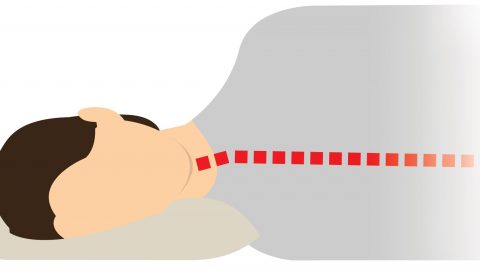
A wall of confusing options.
Are you overwhelmed with all the different types of pillows available?
There are so many different types of pillows available today that finding the right one can be downright confusing. Memory foam, down, microbead, even water pillows are an option in today’s saturated bedding markets.
Unfortunately, no single type of pillow works for everyone. We have choices – lots and lots of choices.
The various types of pillows available today are most easily categorized by what they’re filled with. A quality fabric pillow case, or shell is an important component, but its general character is dictated by the filling. Your pillow’s filling makes it feel the way it does.
Before we dive into all of the different filling options, let’s consider the consistent component of all pillows, the outer fabric case.
We recommend cotton regardless of the filling. It’s the overwhelming favorite for use in bedding products for a reason… It’s soft, breathable and cheap to manufacture. Being that the production of cotton can sometimes result in toxic chemicals being released into the environment, we encourage consumers to purchase certified organic cotton bedding manufactured to OEKO-TEX standards.
A pillow case that has a zippered opening will allow you to adjust its filling to suit your preferences. You can easily change softness/firmness and loft (height) by adding or removing filling from your pillow. Not all pillow types offer this flexibility, but if you’re willing to get hands-on you can purchase filling and a case separately for a DIY pillow!
Each pillow filling has its own advantages/disadvantages and appeals to a unique audience of sleepy heads.
I’ve summarized the most popular pillow types and their features so that you can get a sense of what might be most appropriate for you and your preferred sleeping position.
To represent each of the different types of pillows I’ve chosen a product(s) that appears to be the best of what’s available online currently. Please note that these are not my personal recommendations and I haven’t tried every example pillow in this list. Each is manufactured by a reputable brand with favorable reviews.
A signal exception: our own Hullo buckwheat pillow. We love buckwheat pillows!
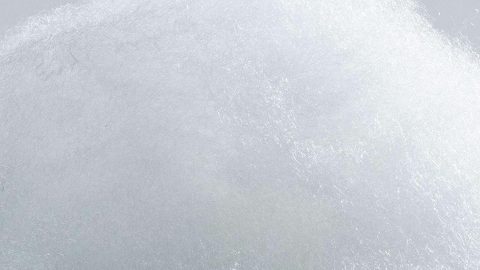
Can you see it? Polyester Pillow Fill
Fiberfill Pillows
Also referred to as Poly-fil, its trademarked name, fiberfill is the cheapest option on our list. Unfortunately it tends to flatten out with use and won’t last as long as some other types of pillows. What’s more, polyester products are manufactured using hazardous chemicals and are a significant contributor to the pollution of our environment. For these reasons, we don’t recommend them except in instances where price is your primary concern.
Polyester Pillow Advantages:
- dirt cheap
- easy to clean
Polyester Pillow Disadvantages:
- polyester fill clumps easily requiring frequent readjustment and loses elasticity with use
- short life span
- potentially hazardous to your health and the environment
Polyester pillows are best for back and side sleepers. Stomach sleepers might also appreciate a polyester-filled pillow if it isn’t too thick.
Polyester Pillow Example: Bare Home Luxury Fiberfill Pillows
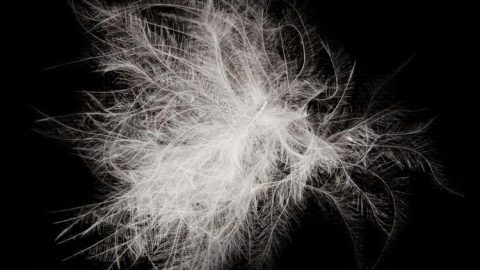 Down Pillows
Down Pillows
The undercoating of a bird’s feathers is called down. More specifically, it’s the bottom, fluffy part of a bird’s feather. Down holds its loft up to 3 times longer than synthetic alternatives and as you probably already know it is very soft.
Hungarian goose down (otherwise known as European white goose down) is considered to be the best quality. These down clusters are pure white and larger than most other types.
A real down pillow contains down only — no feathers. Many manufacturers sell a combination of down and feather fill and label it “down.” Feathers are an economical way to add volume, but often the feathers’ quills will stick through the pillow poking your pretty face (ouch!) while you sleep.
Our friend Martha Stewart is fond of these types of pillows and suggests that you purchase only high-quality down fill due to its longevity.
“I have pillows on my beds that are 10 to 15 years old,” Martha says. In the long run, good-quality down is the least-expensive way to go since it holds up better than synthetic stuffings, which generally wear out in three to four years.
15 years old? I think Martha must take really good care of her pillows!
If you’re concerned about the well-being of animals, down comes at a considerable price.
Down feathers are collected using one of three techniques: 1) post-mortem, after being killed for their meat, 2) live plucking or 3) gathering from live birds. None are humane. Read More: Down and Feather Pillows
Advantages of Down Pillows:
- moldable/malleable – a down pillow tends to hold its shape well, offering good support for your head and neck
- light and cuddly – down pillows are very light (heavy feathers don’t work very well for flying after all!) and soft
- durable – with proper care, a down pillow can last for several years
- sustainable – down is a renewable resource that is biodegradable and recyclable
Disadvantages of Down Pillows:
- requires consistent fluffing to maintain its loft
- difficult to clean
- lack of firm options
- good ones are very pricey (see below)
- the poor birds!
Down pillows work well for all sleep positions.
Down Pillow Examples:
L.L. Bean 700-Fill-Power Sateen White Goose Down Pillow
East Coast Bedding European 800 Fill Power White Goose Down Pillow
Siberian 800 Fill Power White Goose Down Pillow
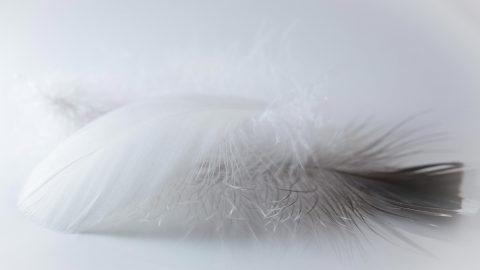
Feather Pillows
Down’s cheap little brother. We recommend you avoid these and spend the extra money on real down if you think this type of pillow is for you.
Unlike down, feathers’ quills naturally begin to align with each other or lay flat. Over time this makes the pillow become flat and uncomfortable. To prevent this, manufacturers often add down clusters to the feathers which slows degeneration. Read More: Down and Feather Pillows
Advantages of Feather Pillows:
- cheap
- light and cuddly just like down
- sustainable – down is a renewable resource that is biodegradable and recyclable
Disadvantages of Feather Pillows:
- “at least 15% of owners report a lingering and unpleasant odor.”
- requires consistent fluffing to maintain its loft due to the quills flattening
- difficult to clean
- again, those poor birds!
Feather pillows are best for back and side sleepers.
Feather Pillow Example: White Goose Feather Bed Pillow
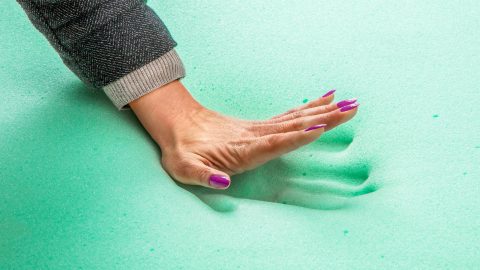
Funky space age memory foam
Memory Foam Pillows
Memory foam is manufactured using polyurethane and several other chemicals, and it unfortunately often emits a strong chemical odor. This “off gassing” of volatile organic compounds is a common and well-documented property of memory foam pillows and mattresses. There are various reports and studies which indicate that memory foam may be somewhat toxic.
Toxicity aside, memory foam is pretty neat! If you’ve ever felt it, you know what I mean: It’s sort of magical the way it retains its shape. I suspect that it’s this “magic” that makes them so popular; people are immediately impressed with the way memory foam feels.
Recently some memory foam pillows have been rebranded “bamboo pillows.” There is no bamboo in memory foam. So what are those sneaky marketers talking about? The truth is in the fine print: apparently only their rayon fabric cover is derived from bamboo. Don’t be tricked into buying what might seem to be an eco-friendly product!
Advantages of Memory Foam Pillows:
- doesn’t clump
- doesn’t require fluffing
- offers good support
Disadvantages of Memory Foam Pillows:
- chemical odor
- potentially dangerous “off-gassing”
- isn’t malleable/moldable
- no loft adjustment
- builds up and retains body heat
Memory Foam Pillows work best for back sleepers. It keeps its shape so there’s no way for side or stomach sleepers to adjust the pillow lower or higher.
Memory Foam Pillow Example: If you’re leaning memory foam, I’d suggest looking at the Essentia Classic Memory Foam Pillow. I’ve never tried it, but it’s marketed as an all natural alternative to the traditional types made with nasty chemicals. If off-gassing doesn’t concern you, the DreamyBlue Pillow at Amazon is favorably reviewed.
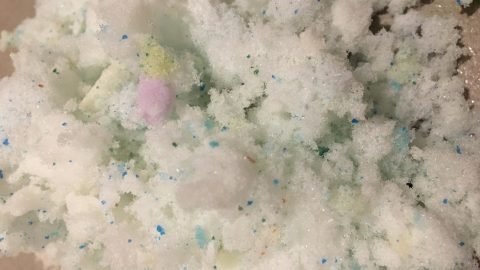 Shredded Memory Foam Pillows
Shredded Memory Foam Pillows
As its name implies, “shredded” memory foam filling is simply torn into tiny chunks. The individual pieces of foam move independently, allowing the pillow to be moldable. You can sculpt it much like a down pillow—it will shift and change into whatever shape you desire. I’ve tested shredded memory foam pillows and found them to be superior to traditional memory foam pillows.
Advantages of Shredded Memory Foam Pillows:
- doesn’t clump
- doesn’t require fluffing
- offers good support
Disadvantages of Shredded Memory Foam Pillows:
- too soft for some, particularly stomach sleepers
- potentially hazardous “off-gassing”
- builds up and retains body heat (they do, however, offer more breathability that a solid memory foam pillow)
Shredded memory foam pillows work best for back and side sleepers. Stomach sleepers might find the soft memory foam pushing uncomfortably upwards into their face.
Shredded Memory Foam Pillow Example: Coop Home Goods Shredded Memory Foam Pillow
Read More: Is a Shredded Memory Foam Pillow Better?
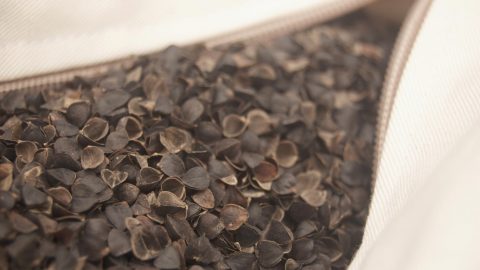
Buckwheat Pillows
First let me be perfectly transparent: we sell buckwheat pillows. We love these things! We’ve tried a lot of different types of pillows, and we think nothing beats an all-natural, old-fashioned buckwheat pillow. We started manufacturing these things because we thought they were the best.
Advantages of Buckwheat Pillows:
- superior support
- breathable/promotes air flow – stays cool all night
- long life-span
- moldable/malleable – it holds its shape and offers terrific support for your head, neck and shoulders
- constructed of all-natural compostable materials
Disadvantages of Buckwheat Pillows:
- buckwheat hulls make a rustling noise when shifted
- heavy — a 20×26″ buckwheat pillow weighs around 8 pounds
- too firm for some
Works best for back, side and stomach sleepers. Everybody can enjoy the benefits of a buckwheat pillow!
Buckwheat Pillow Example: Hullo Buckwheat Pillow

Microbead Pillows
Microbead pillows are filled with what are called “uniform polymer particles,” which, as the name suggests, look like little white beads. They are the synthetic alternative to buckwheat hull pillows and they share a lot of the same characteristics. They both promote air flow and they’re somewhat malleable as well. The most popular of these pillow types is the “Sobakawa Cloud Pillow.” This product uses a misleading name. “Sobakawa” a Japanese word for buckwheat pillow and this pillow contains no buckwheat at all. According to online reviews, microbead pillow owner satisfaction is poor. Users complain that the pillows are too firm and/or flatten after prolonged use. They are completely different from a real sobakawa pillow.
Advantages of Microbead Pillows:
- breathable-keeps cool at night
- moldable/malleable -it holds its shape and offers good support for your head, neck and shoulders
Disadvantages of Microbead Pillows:
- chemical odor and potentially dangerous “off-gassing”
- no variety of firmness or loft (they’re mostly medium firm, medium loft)
- short life span
Microbead pillows work best for back sleepers. The lack of loft variety and adjustability makes them less suitable for other sleeping positions.
Microbead Pillow Example: Sobakawa Cloud Pillow
Read more: The Microbead Pillow Will Comfortably Ruin Us All
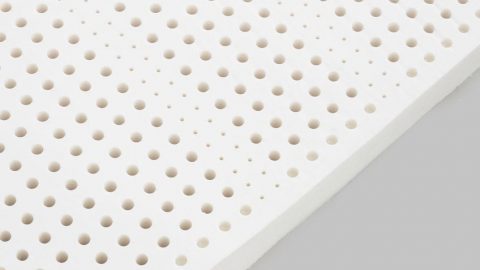
Latex
Latex pillows are becoming quite popular. They offer good support for your head and neck while retaining a soft feel. They’re also relatively breathable providing a cool surface for your tired head. Latex pillows have an owner satisfaction rating rivaling that of our favorite type, buckwheat pillows. For that reason, I bought one for myself to try out. I had high hopes, but I was less than impressed.
Advantages of Latex Pillows:
- great support
- semi-breathable (stays cool)
Disadvantages of Latex Pillows:
- slight “rubbery” odor
- not moldable — no matter what you try, these things will bounce back into their rubbery shape
- too dense and heavy to be considered “cuddly”
They work best for side and back sleepers. Latex pillows are not recommended for stomach sleepers because most have a higher than average loft.
Latex Pillow Example: JUVEA Talalay Latex Pillow
Read more: “Rubbery Rest: A Latex Pillow Review”
Read more: “Shredded Latex Pillow Review”

Water pillow? Not as silly as I expected…
Water Pillows
Water pillows contain, you guessed it, water. Most water filled pillows are simply a plastic reservoir wrapped with polyester foam or down alternative fiberfill. Water pillows are popular due to their ability provide unchanging, solid support. I suspected water pillows were nothing more than a gimmick, but I reviewed one myself and was surprised by its effectiveness.
Advantages of Water Pillows:
- supportive — I’d say it’s a water pillow’s best attribute. Provided you’ve taken the time to fill it properly, a water pillow will consistently keeps your head elevated at just the right level all night long.
- supposed pain relief — While I wasn’t able to determine if my water pillow was indeed capable of reducing pain, but the many positive reviews online and a Johns Hopkins study are evidence of a genuine benefit.
- adjustable — Not many pillow types are adjustable. This is a huge advantage, because it can be very difficult to find the pillow that’s just right for you-they’re always either too thick or thin!
Disadvantages of Water Pillows:
- not moldable — There are no options with a water pillow-it won’t change shape. That pesky water always bounces back.
- some types may be wrapped in a fiberfill that’s too soft— My water pillow was covered in a super soft fill that pushed upward awkwardly into the side of my face.
- leaks (potentially) — I read several water pillow reviews online that mentioned leaks. A wet mattress and flat pillow aren’t conducive to good rest!
- heavy — water isn’t the lightest of pillow filling!
Water pillows are best for back sleepers. but side sleepers may appreciate them as well. Users can adjust the loft to their preference.
Water Pillow Example: Mediflow Original Waterbase Pillow

Kapok Pillows
Kapok, or ceiba pentandra, is a tropical tree native to Mexico that flowers, producing a fluffy, cotton-like material containing hundreds of seeds. This light brown, soft fibre is sometimes referred to as silk cotton.
Kapok’s qualities have made it very popular for filling pillows, upholstery, and even life preservers. Its use has dramatically declined since the introduction of polyester/polyurethane foams. Kapok is currently experiencing a small revival thanks to its all-natural characteristics. I’ve tried them myself.
Advantages of Kapok Pillows:
- free of the potentially toxic materials in many foam pillows
- cruelty-free — the practice of gathering feathers and down for use in pillows is far from humane and kapok, well… it’s not an animal!
- compostable and biodegradable
Disadvantages of Kapok Pillows:
- extremely flammable
- quickly develop lumps, much like polyester foam pillows do
- not moldable, does not hold its shape
Kapok Pillow Example: Bean Products Standard Size Organic Kapok Pillow
Kapok pillows are for all sleeping positions. Most include a zippered opening, so it’s easy to add or remove fill to your preferences.
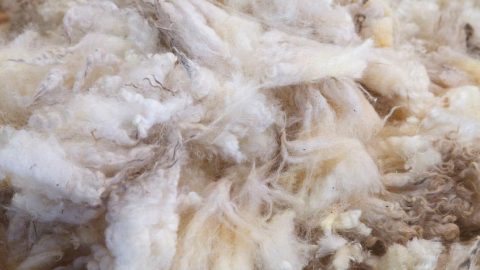
Wool Pillows
Wool’s breathable and insulative qualities make it uniquely suited for use in many different products. For thousands of years it’s been used for clothing, blankets, carpeting, insulation, upholstery and more. Wool, however isn’t extensively used as pillow filling. It has an unfortunate tendency to clump into balls, making your pillow lumpy and inconsistent.
Read More: Can a Wool Pillow Help You Sleep Better (Without Foul Odors)?
Advantages of Wool Pillows:
- free of the potentially toxic materials in many foam pillows
- breathable
Disadvantages of Wool Pillows:
- many complain of foul odors, particularly in humid environments
- with use, wool quickly becomes lumpy and uncomfortable (see above photo)
- not very moldable, does not hold its shape like down or buckwheat hull filling
- some consider wool inhumane
Wool Pillow Example: Natural Australian Wool Filled Pillow

Cotton Pillows
Given cotton’s ubiquity, one would assume that cotton-filled pillows would be reasonably popular. Popular new synthetic types of pillows like memory foam, and polyfill have changed the market. These materials have relegated cotton to a minority position.
I experimented with a cotton pillow and found it only moderately comfortable. That said, I think a cotton pillow is safe and preferable alternative to petroleum based pillow filling like memory or poly foam that is potentially toxic.
Advantages of Cotton Pillows:
- safe: cotton pillows do not contain the potentially toxic materials found in many foam pillows
- odor free
- cooler than many types of pillows like memory foam
- cruelty-free — cotton pillows contain no animal products
- compostable and biodegradable
Disadvantages of Cotton Pillows:
- with use, the filling clumps and flattens
- not moldable, does not hold its shape and thus lacks the support that some other types of pillows can provide
Cotton Pillow Example: Magnolia Organics Organic Cotton Pillow
Cotton pillows are for all sleeping positions. Most include a zippered opening, so it’s easy to add or remove fill to your preferences.
Down Alternative Pillows
Down alternative pillows attempt to mimic down’s advantages while improving upon some of down’s disadvantages.
Read More: Are Down Alternative Pillows Superior to Mother Nature’s?
Advantages of Down Alternative Pillows:
- It is far cheaper than genuine down.
- While a good down pillow can last a very long time if cared for properly, most down alternative pillows are very easy to clean without damaging them.
Disadvantages of Down Alternative Pillows:
- With use, most down alternative filling will develop lumps.
- They’re not moldable or malleable; they do not hold their shape like genuine down pillows.
- They retain more heat than traditional down pillows.
Down Alternative Pillow Example: Queen Anne Down Alternative Pillow
Down alternative pillows are best for side and back sleepers. They’re often too soft and thick for stomach sleepers.
Good luck, pillow shopper.
That’s a lot of information to wade through, but hopefully this enables you to make an informed choice for your next bed pillow. Good luck and please let us know of your favorite types of pillows in the comments below.
* Amazon Affiliate Disclosure: Hulltex LLC (dba Hullo) is a participant in the Amazon Services LLC Associates Program. This is an affiliate advertising program designed to provide a means for sites to earn advertising fees by advertising and linking to amazon.com.


